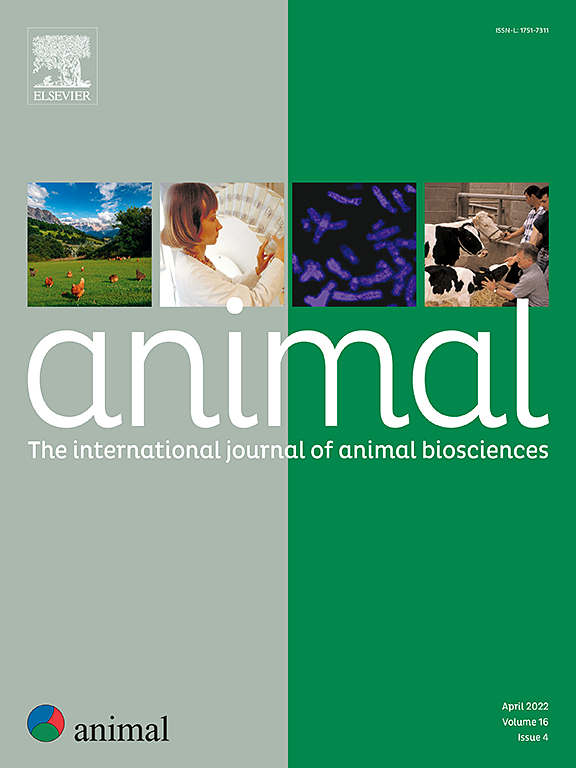消化率栏对生长公牛福利的影响
IF 4
2区 农林科学
Q1 AGRICULTURE, DAIRY & ANIMAL SCIENCE
引用次数: 0
摘要
饲粮消化率和氮平衡是反刍动物营养研究的重要指标。这两项指标通常在1 - 2周的时间内进行评估,届时动物将被限制在所谓的消化隔间中,这在很大程度上限制了它们的活动。在这里,我们的目的是评估公牛在消化畜栏中的福利,并检查是否可以通过缩短畜栏停留时间来限制畜栏相关的福利影响。将16头夏来公牛安置在一个大群栏内,在消化栏内进行2周的禁闭,每隔2.5个月进行两次重复。从第7天开始的10天内,每天在隔间内收集尿液和粪便。从公牛进入畜栏前的7天到它们离开畜栏后的7天,我们每天测量它们的采食量,并使用活动传感器监测它们的姿势(站立与躺卧)和主要活动模式(进食、反刍、其他活动、不活动)。在同一时期,每周评估一次外部病变(脱发、伤口)。从进入畜栏前到进入畜栏10或15天后,每隔3周对尾丛毛发中的皮质醇进行测定。公牛对消化率摊位的反应是吃更少的饲料,花更多的时间站立或不活动,比在群圈里更少的时间进食或反刍。与重复1相比,重复2中不活动时间的增加和进食时间的减少更为明显。不活动的时间在最初的几天里减少了,然后在收集尿液和粪便的几天里又增加了。公牛一旦进入牛栏,就更容易受到损伤的影响。当公牛待在畜栏里时,毛发皮质醇增加了,在重复2的短暂停留后,毛发皮质醇的增加更为明显。综上所述,我们发现明确的证据表明,消化率和氮的测量对动物是有限制的,公牛似乎不习惯在畜栏里的时间。在隔间里的禁闭以及在隔间里的处理都可能对福利产生负面影响。本文章由计算机程序翻译,如有差异,请以英文原文为准。
Impacts of digestibility stalls on the welfare of growing bulls
Diet digestibility and nitrogen balance are essential indicators for studies on ruminant nutrition. Both these indicators are conventionally assessed over 1− to 2-week periods when animals are restrained in so-called digestibility stalls that largely restrict their movements. Here, we aimed to assess the welfare of bulls in digestibility stalls and to check whether stall-related welfare impacts could be limited by shortening the duration of the stay in the stall. Sixteen Charolais bulls accommodated in a large group pen were confined in digestibility stalls for 2 weeks, in two repetitions spaced 2.5 months apart. Urine and faeces were collected daily for 10 days from Day 7 in stalls. From 7 days before the bulls entered the stalls to 7 days after they exited, we measured their feed intake daily and monitored their posture (standing vs lying) and main activity patterns (eating, ruminating, other activity, inactivity) using activity sensors. External lesions (hair losses, wounds) were assessed once a week during the same period. Cortisol was determined in hair from the tail tuft at 3-week intervals from before entering the stalls to after 10 or 15 days in the stalls. Bulls responded to the digestibility stalls by eating lower amounts of feed, spending more time standing or inactive and less time eating or ruminating than when they were in the group pen. The increase in time spent inactive and the decrease in time spent eating were stronger in Repetition 2 than in Repetition 1. The time spent inactive decreased over the first few days in the stalls then increased again over the course of days when urine and faeces were collected. Bulls were more likely to be affected by lesions once they were in the stalls. Hair cortisol increased when the bulls were in the stalls, with a more marked increase after a short stay in Repetition 2. In conclusion, we find definitive evidence that digestibility and nitrogen measurements in digestibility stalls are constraining for animals, and bulls do not appear to habituate to time in the stalls. Confinement in the stalls as well as handling while in the stalls can both have negative welfare impacts.
求助全文
通过发布文献求助,成功后即可免费获取论文全文。
去求助
来源期刊

Animal
农林科学-奶制品与动物科学
CiteScore
7.50
自引率
2.80%
发文量
246
审稿时长
3 months
期刊介绍:
Editorial board
animal attracts the best research in animal biology and animal systems from across the spectrum of the agricultural, biomedical, and environmental sciences. It is the central element in an exciting collaboration between the British Society of Animal Science (BSAS), Institut National de la Recherche Agronomique (INRA) and the European Federation of Animal Science (EAAP) and represents a merging of three scientific journals: Animal Science; Animal Research; Reproduction, Nutrition, Development. animal publishes original cutting-edge research, ''hot'' topics and horizon-scanning reviews on animal-related aspects of the life sciences at the molecular, cellular, organ, whole animal and production system levels. The main subject areas include: breeding and genetics; nutrition; physiology and functional biology of systems; behaviour, health and welfare; farming systems, environmental impact and climate change; product quality, human health and well-being. Animal models and papers dealing with the integration of research between these topics and their impact on the environment and people are particularly welcome.
 求助内容:
求助内容: 应助结果提醒方式:
应助结果提醒方式:


